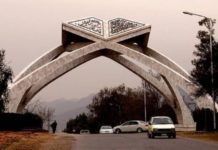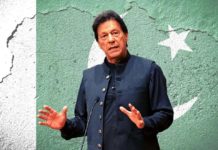It was once common wisdom that India had succeeded in developing a viable form of Westminster-style parliamentary democracy whereas Pakistan had failed. Pakistan has indeed suffered a succession of military governments interspersed with periods of nominally civilian rule; as such, it is not a model worthy of emulation. But the rise of Hindutva politics has taken away the starkness of earlier comparisons. Even if there is little danger of military rule in India, the viability of a system where political success lies in appealing to the basest of human instincts and to the availability of vast sums of money, is questionable.
When the two sovereign countries emerged in 1947 neither had any experience with the process of democratic governance. Literacy rates were low, production was largely agrarian and there was no mega resource like oil. Both countries comprised disparate regions with a multitude of different languages, landscapes, climates and cultures. Yet, in time, they managed to invent their own national identities and constitutions.
Formally both countries are democracies. But what democracy means and which sections of the population may enjoy democratic representation, is being continuously redefined as the decades roll by. India’s 900 million eligible voters – numbering more than the entire population of Europe – are presently at polls scheduled to end on 19 May 2019. Whereas the Bharatiya Janata Party’s (BJP) Narendra Modi is the front runner, a resurrected Rahul Gandhi is giving the Congress a fighting chance. The outcome will significantly redefine India.
The Indian elections are more important for India than Pakistan’s were for Pakistan. Pakistan, with 106 million registered voters, concluded its elections on 25 July 2018 with the election of Imran Khan as prime minister. While many of his naïve supporters were promised otherwise, it was unreasonable to expect fundamental changes. Whoever was to win would be secondary, the military would continue making all the big decisions on foreign policy, nuclear weapons and would continue to gobble up national resources. Indeed for all the ‘Naya Pakistan’ rhetoric from Khan, little change is visible nine months later.
Even if the two systems are now converging in some ways, one should not hastily conclude that Indian and Pakistani versions of democracy have become identical – they are not. The viability of any political system should ultimately be judged upon how well and fairly it allows for representative government; its ability to deal with governance issues such as employment and allocation of resources; and the extent to which the rule of law prevails and corruption is effectively combatted. These cannot be discussed here.
Instead I focus upon three election related matters: the extent to which religious-communal feelings are used for vote-getting; the mobilisation of nationalistic feelings against the other (again for vote-getting); and the integrity of the electoral process.
The Communal Card
Pakistan’s 2018 elections were substantially free of any significant communal agenda. No major political party drummed up sentiment against any religious sect other than Ahmadis, who were declared non-Muslims after an act of Parliament in 1974. That’s because post-Partition demographics have made Pakistan’s minorities irrelevant to mainstream politics.
Of course, this took a while to happen. The first step was the Objective Resolution of 1949, which gave Islam and Muslims primacy and formally reduced non-Muslims to the status of a minority. Then in 1956 Pakistan became the Islamic Republic of Pakistan. This formally privileged Muslims over all other people living within its geographical boundaries. Rejection of pluralism was subsequently written into Pakistan’s 1973 constitution, which explicitly states that only a Muslim may be head of state.
The floodgates opened after General Zia-ul-Haq ordered the creation of an alternate reality, one depicting all Indian history as battles between virtuous Muslims against cunning Hindus. School textbooks thereafter claimed that Pakistan dated back to 712 AD when Muhammad bin Qasim conquered Sind. Of course, Jinnah too had claimed the same, although it is unlikely that he believed it. More likely, as an excellent lawyer, he saw this as a valuable debating point.
The purge of Hindu influences in Pakistan was seriously initiated in the 1980s. Public buildings and facilities bearing Hindu names were renamed and even the celebration of cultural events such as Baisakhi, Basant and flying of kites was discouraged. ‘Hindu trees’ like banyan, neem and pipal were punished – far fewer can be seen today in comparison to earlier times. In 2003, students from a nearby madrassa in Islamabad’s posh E-7 area set on fire a 200-year old banyan tree, seeing it as a relic of past Hindu/Buddhist influence.
All this could then be justified because India was assumed to be doing the same even if it said otherwise. During his days as prime pinister, Jawaharlal Nehru was known in Pakistan only as a Hindu adversary of Jinnah, implacably opposed to Pakistan on account of his religion. That he was avowedly atheist, together with his insistence that India was to be liberal and syncretic, counted for naught. His claim that India’s strength would derive from religious diversity was openly disbelieved and mocked, rejected as a ruse justifying Hindu majoritarian rule. The Congress-RSS enmity was dismissed as cosmetic, a petty domestic issue that pitted Tweedledum against Tweedledee.
India, albeit a late starter, is now keen to follow Pakistan’s path. Uninhibited communalism is the vote-getter for BJP candidates, such as party president Amit Shah, who, at an election rally in Bengal’s Raiganj, reduced Muslim Bangladeshi refugees to insects: “The illegal immigrants are like termites. They are eating the grain that should go to the poor, they are taking our jobs.” Maneka Gandhi, wife of the late Sanjay Gandhi, long broke away from the Nehru legacy and is running on a BJP ticket. She made her debut into religious politics by declaring, “I am contesting the polls as a mother. Sultanpur is known as land of Lord Kush and it should be named Kushbhawanpur.”
Indeed, renaming is now the rage in BJP’s India. Allahabad has become Prayagraj and Mughalsarai Junction Railway Station has officially been renamed Deen Dayal Upadhyaya Junction. Three years earlier, the signs for Aurangzeb Road in Delhi were painted over to bear a new name – APJ Abdul Kalam Road. More changes lie ahead.
Renaming cities and roads is just one part of Hindutva’s larger agenda to glorify the Vedic era and vilify Muslim rulers. Bit by bit, India’s cultural landscape and education system is being altered to exalt an imaginary past of a pure Bharat Mata undefiled by invaders. Modi says India is troubled by “1200 years of slave mentality”. Dinesh Sharma, Yogi Adiyanath’s deputy, put it still more bluntly: “Mughals were not our ancestors, they were actually plunderers. They looted the country. This is not our history.”
Has there been outrage in Pakistan at the destruction of Muslim heritage and targeting of fellow Muslims across the border – and particularly cow-related lynchings? None can be seen. Even in the normally virulent Urdu press, commentary on it has been sparse. Significantly, Pakistan has not attempted to take India’s crimes against its religious minorities to any international forum. For all its highly-paid, glib-tongued representatives in the United nations (UN) and elsewhere, Pakistan has been remarkably quiet.
It’s easy to see why. By and large, there’s a kind of smug satisfaction because the heinous acts of Hindutva groups against Indian Muslims are seen as proof that validate Savarkar’s and Jinnah’s two-nation theory. Pakistan has long marginalised and mistreated its minorities. How can the pot call the kettle black?
Hyper-nationalism
Partition essentially ended contact between peoples who had once lived intimately with each other over centuries, sometimes peacefully and sometimes not. Pakistani governments discouraged their citizens from cross-border visits lest they value their Indian heritage too much in the early years after Partition but, in later decades, the Indian state was to create equally high hurdles for Pakistanis, simply because it wanted no identification with the enemy. Eventually, the two peoples had little engagement, except for hostile military confrontations, even if, at some level, they were able to relish each other’s cultural products.
These days, aggressive nationalism pays well in Southasia: to be seen as ‘soft’ on the other could be fatal for any Pakistani or Indian leader. In the 2018 elections, Nawaz Sharif paid in full the price for his alleged ‘friendship’ with Narendra Modi, who, in December 2015, dropped by at Sharif’s residence ostensibly for attending his granddaughter’s wedding. This photo-op by itself would have been insignificant and quickly forgotten but for the fact that Sharif had lost enthusiasm for the Kashmir cause.
Sharif’s deepening conflict with Pakistan’s security establishment was exposed by the ‘Dawn leaks’ episode in October 2016. Their relationship was uncomfortable principally because Sharif was insisting on some form of accommodation with India and dispensing with militant organisations harboured inside Pakistan. Although his fate was later sealed by the Panama Papers that revealed his financial shenanigans, in fact he was seriously weakened once the military made clear its opposition to him. Just months before the 2018 elections, Sharif and his right wing Pakistan Muslim League- Nawaz (PML-N) party were seen as unbeatable. But soon thereafter the ultra-right peeled off PML-N’s right-wing vote and militant leaders like Hafiz Saeed and Masood Azhar pilloried Sharif endlessly.
The pre-election Imran Khan displayed classic opportunism in attacking Nawaz Sharif. Forgetting that Khan had been warmly met by Modi in Delhi earlier, his supporters took on as their favorite chant, “Modi Ka Jo Yaar Hai, Ghaddar Hai, Ghaddar Hai (any friend of Modi is a traitor)”. Khan accused Sharif of being a sellout who was now creating an artificial security crisis at the Pakistan-India border to distract attention. Still, history does occasionally bite back: there was uproar in Pakistan’s national assembly after Khan inadvertently blurted out during his visit to Teheran on 23 April 2019 that terrorists were using Pakistani territory to launch attacks upon Iran.
And yet, in all fairness, it seems that in recent times Pakistan’s India obsession is being squarely outdone by India’s Pakistan obsession. With his initial overtures to Nawaz Sharif being all but forgotten, in these post-Pulwama election times, Narendra Modi rushes around to demonstrate his muscularity and 56-inch chest. Testosterone levels shot up on both sides after India’s attempt to bomb a Jaish-e-Muhammad seminary in Balakot, leading to a Pakistani retaliation in which India lost a Mig-21 Bison. Pakistan plausibly says the bombs missed but India’s official machinery insists – without supplying proof – that hundreds of terrorists were killed. Whatever the truth, today one sees an astonishing situation where, on either side of the border, most people are soundly convinced that their side won and the other was ‘taught a lesson’.
Jingoism moved to yet a higher level when, addressing an election rally in Rajasthan on 21 April, Modi declared that India would no longer submit to Pakistan’s nuclear blackmail because India too had nuclear weapons: “What do we have then? Have we kept our nuclear bomb for Diwali?” Declaring that India has the capability to launch nuclear attacks from land, air and sea, he lambasted Congress leaders for demanding evidence of success in the air strikes. As in earlier election rallies, he once again threatened to abrogate the Indus Waters Treaty – which would surely pitch a desperate lower riparian Pakistan to take extreme measures.
Sensible people must ask: even if Pakistan were annihilated by India’s fearsome triad, would India survive? Given how weapons and delivery systems have multiplied everywhere, the answer is no. With missile flight times of a few minutes only (and thus marginal warning times), the best that either country can hope for is second strike capability. However, the first strike will have already caused a catastrophe beyond imagination.
Integrity of Elections
Among other things, democracy needs elections. Controlled elections are always a blow against democracy and proper elections require a level playing field. Else, public confidence in political institutions and processes is undermined and the legitimacy of those elected is weakened or lost altogether. Apart from actual vote tampering, there are two other major ways in which electoral integrity can be compromised. One, if some external power or institution intervenes to change the outcome. Two, through injection of game-changing funds by individuals and institutions that stand to gain power and influence at the expense of the general good.
The 2018 elections that brought Imran Khan into power were visibly unfree and unfair. The banning of Nawaz Sharif from holding political office for financial corruption turned out to be first step towards a systematic dismantling of his party. Mysterious desertions from PML-N ranks, a coup in the Balochistan assembly, the sudden appearance of ‘Jeep’ (army sponsored) candidates across the country unnerved the government. Along with a whispering campaign that PML-N candidates will run afoul of the “khalaee makhlooq” (hidden powers) – these sapped the strength of Sharif’s party.
At this point, the military establishment played yet another card. For three decades it had routinely denied supporting violent religious groups irrespective of whether a group’s target lay across national borders or aimed to achieve specific political objectives within Pakistan. But now its attitude suddenly turned ambivalent as serving and retired senior army officers began openly expressing support for some groups. These included the newly emerged religious parties opposed to the PML-N government, notably Hafiz Saeed’s Milli Muslim League (MML) and Khadim Hussain Rizvi’s Tehreek Labbaik Ya Rasool Allah (TLYRA). As in the by-elections to constituency vacated by the disqualification of Nawaz Sharif following his conviction on corruption, shock followed shock as opposition from extremists and militants somehow suddenly mainstreamed into support for new political parties. Nawaz’s party, which had secured 166 in Parliament in the 2013 elections soon found itself running neck to neck against Imran Khan’s Pakistan Tekrik-e-Insaaf (PTI), which had won only 35 earlier.
One could still have hoped for some degree of fairness if there had not been such determined, systematic gagging of television and the press. The slant was impossible to miss. To emphasise the Army’s preferences, The Director General of Inter-Services Press Relations, the media wing of Pakistan’s armed forces, Major General Asif Ghafoor held a press conference on 4 June 2018 to praise the media for its positive role, to identify friend and foe among TV anchors and journalists and to criticise the ‘anti-state’ feelings in the social media. Ominously, he referred to the Army’s ability to monitor individuals in cyberspace.
India’s election process faces an entirely different set of challenges to its integrity. BJP’s sponsors are among the richest of the rich and Modi’s re-election bid has received huge financial backing from corporate India, outdoing the Congress substantially. Although he had promised to crack down on what he called “crony capitalism”, Modi’s supporters have gained the most during his tenure. Mukesh Ambani, known for his stunningly ostentatious displays of wealth, calls Modi “our beloved prime minister”. According to Forbes, Ambani’s net personal worth soared from USD18.6 billion when Modi came to power to USD 53 billion today.
Modi is not the only one who has not delivered upon multiple impossible promises. Imran Khan, too, had moved heaven and earth in his messianic mission against corruption. But, even before the end of his first year in office, he is already being seen as a puppet prime minister with strings held by the army as well as big corporate and landed (particularly sugar) interests. These interests allegedly led to the unceremonious booting out of finance minister Asad Umar, one of his oldest and closest supporters. Soon thereafter the State Bank governor was also removed. Cricketer Khan is today being visibly manipulated by men who amassed enough wealth to buy their way into politics – which in turn would help them become richer. His pledges to eliminate corruption from Pakistan within 90 days of being elected are now the butt of many jokes.
***
Will the 2018/2019 elections help Pakistanis and Indians become more capable of self-government, better able to determine their futures, reduce poverty and illiteracy? Or is Southasian politics doomed to be no more than mud-slinging games where wealthy, power-hungry individuals play musical chairs?
The answers are not clear. Certainly, one must welcome all opportunities for exercising democratic choice, such as electing parliamentary representatives. At a local level it is important to have competitions among those who promise to deliver on social services. In a better world, genuine politics would have parliamentary candidates selling ideas of how to bring water to two countries that are becoming drier by the year; cleaning up an environment that is filthy and polluted; creating employment for the teeming millions entering the job market every year; figuring out how to deal with an exploding population bomb; and dealing with crazed religious maniacs who are an existential menace to society.
The bottom line: Hindu majoritarianism and Muslim majoritarianism are equally ugly and repulsive. One must fear systems where vote-getting depends on pandering to popular prejudices, often creating deeply destructive religious or ethnic divisions. A rational outlook would be to recognise that all countries and their people are products of peculiar historical circumstances. Should one simply surrender to the blind forces that have created our present identities? Or can we dare to move ahead and work towards creating genuinely pluralistic societies that value and encourage diversity? Willingness to work out the answers shall determine whether India and Pakistan will become truly democratic countries someday.









